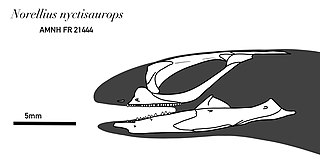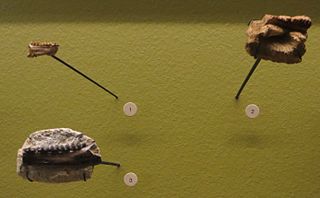
The Coraciiformes are a group of usually colourful birds including the kingfishers, the bee-eaters, the rollers, the motmots, and the todies. They generally have syndactyly, with three forward-pointing toes, though in many kingfishers one of these is missing. The members of this order are linked by their "slamming" behaviour, thrashing their prey onto surfaces to disarm or incapacitate them.

Gekkonidae is the largest family of geckos, containing over 950 described species in 62 genera. The Gekkonidae contain many of the most widespread gecko species, including house geckos (Hemidactylus), the tokay gecko (Gekko), day geckos (Phelsuma), the mourning gecko (Lepidodactylus), and dtellas (Gehyra). Gekkonid geckos occur globally and are particularly diverse in tropical areas. Many species of these geckos exhibit an adhering ability to surfaces through Van der Waals forces utilizing intermolecular forces between molecules of their setae and molecules of the surface they are on.

The Lacertidae are the family of the wall lizards, true lizards, or sometimes simply lacertas, which are native to Afro-Eurasia. It is a diverse family with at about 360 species in 39 genera. They represent the dominant group of reptiles found in Europe.

Euleptes is a genus of geckos represented by the European leaf-toed gecko, the sole extant species.

Pterodon is an extinct genus of hyaenodont in the family Hyainailouridae, containing five species. The type species Pterodon dasyuroides is known exclusively from the late Eocene to the earliest Oligocene of western Europe. The genus was first erected by the French zoologist Henri Marie Ducrotay de Blainville in 1839, who said that Georges Cuvier presented one of its fossils to a conference in 1828 but died before he could make a formal description of it. It was the second hyaenodont genus with taxonomic validity after Hyaenodon, but this resulted in taxonomic confusion over the validities of the two genera by other taxonomists. Although the taxonomic status of Pterodon was revised during the late 19th and early 20th centuries, it became a wastebasket taxon for other hyaenodont species found in Africa and Asia. Today, only the type species is recognized as belonging to the genus while four others are pending reassessment to other genera.
Azibiidae is an extinct family of fossil primate from the late early or early middle Eocene from the Glib Zegdou Formation in the Gour Lazib area of Algeria. They are thought to be related to the living toothcombed primates, the lemurs and lorisoids, although paleoanthropologists such as Marc Godinot have argued that they may be early simians. It includes the genera Azibius and Algeripithecus, the latter of which was originally considered the oldest known simian, not a strepsirrhine.

Xiphodon is the type genus of the extinct Palaeogene artiodactyl family Xiphodontidae. It, like other xiphodonts, was endemic to Western Europe and lived from the middle Eocene up to the earliest Oligocene. Fossils from Montmartre in Paris, France that belonged to X. gracilis were first described by the French naturalist Georges Cuvier in 1804. Although he assigned the species to Anoplotherium, he recognized that it differed from A. commune by its dentition and limb bones, later moving it to its own subgenus in 1822. Xiphodon was promoted to genus rank by other naturalists in later decades. It is today defined by the type species X. gracilis and two other species, X. castrensis and X. intermedium.

Gobekko is an extinct genus of gecko or gecko-like lizard from the Late Cretaceous Djadokhta Formation of the Gobi Desert in Mongolia. Gobekko is either a basal member of Gekkota, the group that includes geckos and the legless pygopodid lizards, or a stem-gekkotan outside Gekkota but within the larger group Gekkonomorpha. It is the fourth oldest known member of Gekkonomorpha after Hoburogekko, a gecko from the Early Cretaceous of Mongolia, AMNH FR21444, an unnamed specimen also from the Early Cretaceous of Mongolia, and Cretaceogekko, a gecko preserved in amber from the Early Cretaceous of Burma.
Hoburogekko is an extinct genus of stem-group gecko that includes a single species, Hoburogekko suchanovi, from the Early Cretaceous Dzunbain Formation of Mongolia. It is known from two fossil specimens, one preserving the front part of the skull and the other preserving part of the lower jaw. Hoburogekko is one of four known Mesozoic geckos or gecko-like lizards, the others being Cretaceogekko from the Early Cretaceous of Burma, AMNH FR21444, an undescribed specimen from a slightly older deposit in Mongolia, and Gobekko from the Late Cretaceous of Mongolia. Hoburogekko is the third oldest known gecko behind AMNH FR21444 and Cretaceogekko.

Necromantis is an extinct genus of bat that lived during the Eocene. Its fossils are found in the Quercy Phosphorites Formation of France and the Djebel Chambi in Tunisia. Specimens of Necromantis are notable for their large size and specialization towards a predatory lifestyle.

Norellius is an extinct genus of scleroglossan lizard from the Early Cretaceous Öösh Formation of Mongolia. It is known from a well-preserved skull that was collected by an American Museum of Natural History expedition to Mongolia in 1923 and cataloged as AMNH FR 21444. After its initial cataloging, the specimen was not mentioned again in the scientific literature until 2004, when it was recognized as belonging to a potential early relative of modern groups of squamates such as gekkotans, amphisbaenians, dibamids, and snakes. AMNH FR 21444 was more fully described in a 2006 study that used high-resolution computed tomography to examine the skull and its braincase, and was described as a new genus and species, Norellius nyctisaurops, in 2015. The genus name honors paleontologist Mark Norell. The 2006 study incorporated the specimen into a phylogenetic analysis and found it to be a basal member of an evolutionary grouping called Gekkonomorpha, a stem-based taxon that includes living geckos and legless lizards (pygopodids) and all taxa more closely related to them than to any other living lizard. Norellius lies outside the node-based taxon Gekkota, a more strictly-defined subgroup of Gekkonomorpha that includes geckos, pygopodids, and all descendants of their most recent common ancestor. Therefore, while Norellius is more closely related to geckos and pygopodids than it is to any other living group of lizards, it branched off before the most recent common ancestor of these two groups. Below is a cladogram showing the position of Norellius according to this phylogeny:

Eichstaettisaurus is a genus of lizards from the Late Jurassic and Early Cretaceous of Germany, Spain, and Italy. With a flattened head, forward-oriented and partially symmetrical feet, and tall claws, Eichstaettisaurus bore many adaptations to a climbing lifestyle approaching those of geckoes. The type species, E. schroederi, is among the oldest and most complete members of the Squamata, being known by one specimen originating from the Tithonian-aged Solnhofen Limestone of Germany. A second species, E. gouldi, was described from another skeleton found in the Matese Mountains of Italy. Despite being very similar to E. schroederi, it lived much later, during the Albian stage. Fossils of both species show exceptional preservation due to deposition in low-oxygen marine environments.

Hyainailouridae ("hyena-cats") is a family of extinct predatory mammals within the superfamily Hyainailouroidea within extinct order Hyaenodonta. Hyaenodontids arose during the middle Eocene and persisted well into the middle Miocene. Fossils of this group have been found in Asia, Africa, North America and Europe.

Yantarogekko is an extinct genus of gecko known from a single specimen found in Baltic amber from the Eocene Prussian Formation of Kaliningrad, Russia. The remains consist of the anterior half of a body with partially preserved limbs, lacking a skeleton. While considered in its initial description to be a member of the family Gekkonidae, the limited nature of known remains combined with its morphology not closely resembling any living family of geckos make it impossible to assign it any more precisely than Gekkonoidea.

Dichodon is an extinct genus of Palaeogene artiodactyls belonging to the family Xiphodontidae. It was endemic to Western Europe and lived from the middle Eocene up to the earliest Oligocene. The genus was first erected by the British naturalist Richard Owen in 1848 based on dental remains from the fossil beds in Hordle, England. He noticed similar dentitions to contemporary artiodactyls like those of the Anoplotheriidae and Dichobunidae and references the name of the genus Dichobune. Eventually, it was found to be more closely related to Xiphodon and now includes 11 species, although one of them may be synonymous.

Retinosaurus is an extinct genus of scincomorph lizard from the Early Cretaceous of Myanmar. The genus contains a single species, Retinosaurus hkamtiensis, known from a specimen preserved in amber.
This list of fossil reptiles described in 2023 is a list of new taxa of fossil reptiles that were described during the year 2023, as well as other significant discoveries and events related to reptile paleontology that occurred in 2023.

Thaumastosaurus is an extinct genus of frogs in the family Pyxicephalidae. Five species are known, all from the Eocene of western Europe, including France, England, and Switzerland. Specimens of the species T. gezei from the Quercy Phosphorites of France are known for their exceptional preservation, providing three-dimensional images of the animal's life appearance.
Haplomeryx is an extinct genus of Palaeogene artiodactyls belonging to the family Xiphodontidae. It was endemic to Western Europe and lived from the middle Eocene up to the earliest Oligocene. Haplomeryx was first established as a genus by the German naturalist Max Schlosser in 1886 based on a molar tooth set from Quercy Phosphorites deposits. Three additional species were erected and classified to the xiphodontid genus while one other species, first recognized in 1822, was tentatively classified to it and remains unresolved in affinity.
Idicia is an extinct genus of Palaeogene rodents belonging to the family Theridomyidae. The genus and its sole species Idicia vidalenci were both named by Monique Vianey-Liaud et al. in 2024 based on some holotype dentition from the French locality of Lavergne, dating to the middle Eocene. It was named in honor of Dominique Vidalenc, who discovered the holotype material. It is diagnosed as being a medium-sized and brachyodont (low-crowned) theridomyid with various specific morphologies of its cuspids. A wide range of other faunas were recovered form Lavergne along with Idicia such as the herpetotheriid Peratherium, nyctithere Saturninia, omomyid Necrolemur, carnivoraforme Quercygale, tapirulid Tapirulus, and the palaeothere Palaeotherium.















